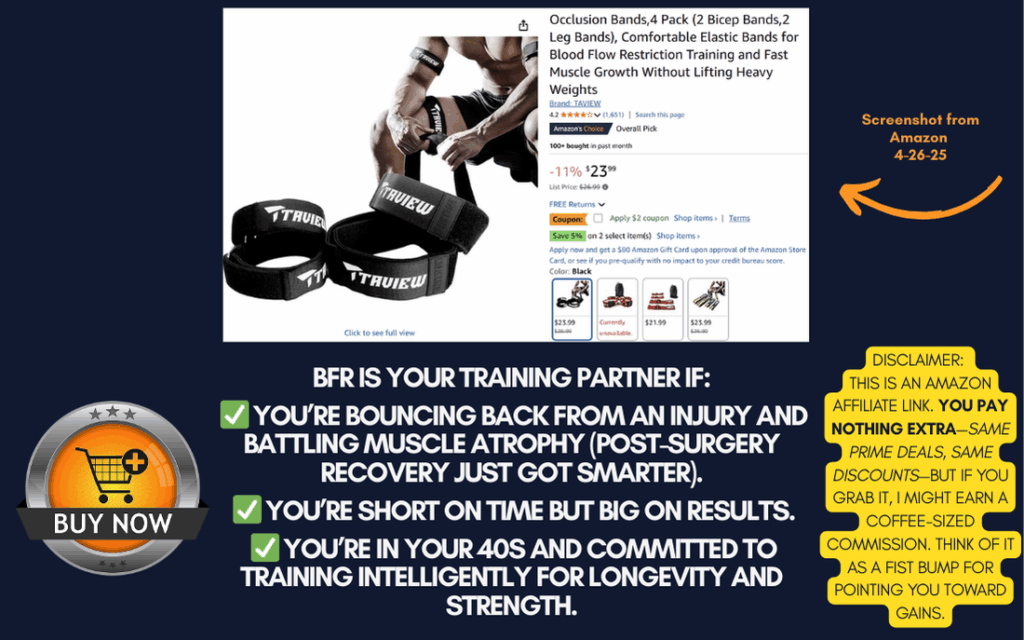If you’ve spent any time in a gym, physical therapy clinic, or living under a rock, you’ve likely heard whispers—or shouts—about Blood Flow Restriction Training (BFR). This technique, often dubbed “occlusion training,” involves using specialized cuffs or bands to partially restrict blood flow to muscles during exercise. The result? You can lift lighter weights, tax your joints less, and still trigger muscle growth akin to heavy lifting. For athletes, rehab patients, or time-crunched lifters chasing aesthetics, function, or sport-specific gains, BFR isn’t just a trend—it’s a physiological hack rooted in science.
The Alchemy of BFR: How Restriction Becomes Growth
Picture this: You’re curling 15-pound dumbbells, but your biceps scream like you’re hoisting 50s. That’s BFR in action. By strategically limiting venous return (blood leaving the muscle) while allowing arterial flow (blood entering), you create a metabolic storm. Lactic acid pools, oxygen-starved fibers fire SOS signals, and your body responds by dumping growth factors like a nervous gambler at a blackjack table.
“BFR isn’t magic—it’s controlled strangulation of your gains,” says Eugene Thong, CSCS. “You’re tricking your physiology into thinking it’s lifting heavy, even when it’s not.”
The science hinges on cellular stress and anabolic signaling. Low-load resistance (20-30% of your 1RM) paired with occlusion:
- Accelerates hypertrophy by recruiting fast-twitch fibers prematurely.
- Spikes growth hormone 290% above baseline (yes, really).
- Preserves joints while still hammering muscle.
Who Should (and Shouldn’t) Dance with BFR
BFR is for you if:
✅ You’re rehabbing an injury (post-surgery atrophy, meet your nemesis).
✅ You’re a seasoned athlete chasing sport-specific endurance without bulk.
✅ You’re time-poor but refuse to sacrifice gains (20-minute sessions FTW).
✅ You’re over 40 and want to lift smarter, not harder.
Avoid BFR if:
❌ You have hypertension, blood clots, or vascular issues.
❌ You’re new to resistance training (master form first).
❌ You’re a masochist who thinks “pain is gain” (BFR requires precision, not recklessness).

Pros vs. Cons: The Unvarnished Truth
| Pros | Cons |
|---|---|
| Build muscle with lighter loads | Improper technique risks injury |
| Boost aerobic capacity + strength | Temporary numbness/discomfort |
| Speed up rehab without overloading | Not for ego lifters (leave the 1RMs at home) |
| Enhance recovery between sessions | Requires equipment (cuffs/bands) |
How to BFR Like a Pro: A 4-Step Blueprint
- Choose Your Weapon: Use pneumatic cuffs or elastic bands. Avoid knee wraps or old T-shirts.
- Wrap Smart: Apply pressure at 7/10 tightness (arms) or 8/10 (legs) proximal to the muscle.
- Lift Light, Lift Right: 20-30% of your 1RM for 15-30 reps, 3-4 sets. Rest 30 seconds between sets.
- Time It: Keep sessions under 20 minutes. Your muscles will beg for mercy by minute 15.
“BFR is a scalpel, not a sledgehammer,” warns Charles Damiano, B.S. Clinical Nutrition. “The goal is metabolic chaos, not vascular collapse.”
The Hidden Cost of Ignoring BFR
Imagine standing at the edge of two paths:
- Path 1: Grind through heavy lifts, joints creaking, time evaporating.
- Path 2: Lift smarter, recover faster, and harness the storm inside your own veins.
BFR isn’t for everyone. But if you’re chasing longevity, lean muscle, or a way to outwit Father Time, it’s a tool worth mastering. Your future self—the one still deadlifting at 65—will raise a protein shake in your honor.
Unmasked: The BFR Questions You Never Knew to Ask
A: While BFR is celebrated for muscle hypertrophy, its impact on tendons is a darker horse. By combining low-load resistance with occlusion, BFR creates a unique mechanical stress environment that may stimulate tendon collagen synthesis. The restricted blood flow forces tendons to adapt to metabolic and tension demands differently than traditional training. Eugene Thong, CSCS, notes, “Tendons are slow adapters—BFR’s constant tension under fatigue could be the nagging whisper they need to remodel.” However, overzealous use risks irritation; treat tendons like crockpot recipes, not microwave meals.
A: Think of BFR as a metabolic amplifier—it turns your post-workout shake into a VIP backstage pass for nutrients. By creating cellular panic (oxygen debt, metabolite buildup), your muscles become hyper-receptive to protein and carbs. Eugene Thong notes, “BFR’s hunger for glycogen and amino acids is like a black hole—feed it within 30 minutes, or miss the vortex.” Pair it with fast-digesting whey and simple carbs to exploit the anabolic window. But skip the feast if you’re pairing BFR with fasting; you’ll muddy the metabolic waters.
A: BFR isn’t just muscle-deep—it’s a covert op for battered joints. When heavy squats are off the table (hello, tendonitis), low-load BFR leg extensions can maintain quad mass without shearing forces. Charles Damiano explains, “BFR keeps mechanical stress low but metabolic stress high—it’s like renovating a house while you’re still living in it.” Use it during deloads or rehab to preserve muscle while tissues heal. Just don’t crank the cuff pressure; your arteries aren’t enemies.
A: BFR is Father Time’s kryptonite. It lets you lift lighter but age harder. By stressing muscles without joint punishment, you trigger hypertrophy pathways that heavy weights often neglect. “Older lifters get the anabolic response of their 20s with the joint load of their 60s,” says Thong. Pair BFR with compound lifts (e.g., BFR pull-downs after deadlifts) to amplify gains. Just remember: Your veins aren’t as supple as they once were—keep pressure moderate.
A: Rest days with BFR are like jazz improvisation—structured chaos. Light BFR sessions (10-15 reps, 20% 1RM) boost recovery by flushing waste products, increasing nutrient delivery, and reducing soreness. “It’s active recovery with teeth,” says Damiano. But tread carefully: This isn’t a green light to train daily. Use it sparingly—like hot sauce on eggs—to avoid overcooking your nervous system.

Final Rep
Blood Flow Restriction Training isn’t a shortcut—it’s a force multiplier. Whether you’re sculpting aesthetics, rebuilding function, or sharpening athletic performance, BFR bends physiology to your will. But respect the science. Wrap wisely. Lift intentionally. And let your oxygen-starved muscles sing the anabolic hymns of growth.
YOUR NEXT STEPS:
